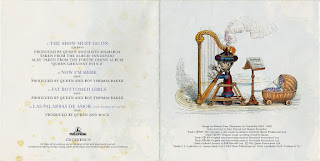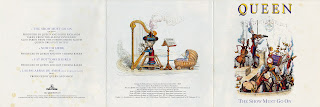It was released as a single in the United Kingdom on 14 October 1991 in promotion for the Greatest Hits II album, just six weeks before Mercury died. Following Mercury's death on 24 November 1991, the song re-entered the British charts and spent as many weeks in the top 75 (five) as it did upon its original release, initially reaching a peak of 16. A live version with Elton John on vocals appeared on Queen's Greatest Hits III album.
The song was first played live on 20 April 1992, during The Freddie Mercury Tribute Concert, performed by the three remaining members of Queen, with Elton John singing lead vocals and Black Sabbath guitarist Tony Iommi playing rhythm guitar. It has since been played live by Queen + Paul Rodgers with Rodgers citing one of the performances as the best of his career. Since its release, the song has appeared on television, film, and has been covered by a number of artists.
After listening to John Deacon and Roger Taylor playing the chord sequence that later on would be the basis for almost the entire song, Brian May sat down with Freddie Mercury and the two of them decided the theme of the song and wrote some lyrics. May wrote down the rest of the words as well as the melody, and added a bridge with a chord sequence inspired by Pachelbel's Canon.
Demo versions featured May singing, having to sing some parts in falsetto because they were too high. When Brian May presented the final demo to Mercury, he had doubts that Mercury would be physically capable of singing the song's highly demanding vocal line, due to the extent of his illness at the time. To May's surprise, when the time came to record the vocals, Mercury consumed a measure of vodka and said "I'll fucking do it, darling!" then proceeded to perform the vocal line.
For the record, May sang most of the backing vocals (including the very last line) and played Korg M1 synthesiser as well as guitar. Producer David Richards suggested the key-shift in the second verse.
"The Show Must Go On" came from Roger and John playing the sequence, and I started to put things down. At the beginning, it was just this chord sequence, but I had this strange feeling that it could be somehow important, and I got very impassioned and went and beavered away at it. I sat down with Freddie, and we decided what the theme should be and wrote the first verse. It's a long story, that song, but I always felt it would be important because we were dealing with things that were hard to talk about at the time, but in the world of music, you could do it.
— Brian May – 1994
The lyrics are full of allusions, metaphors and other figures of speech, making it somewhat difficult to understand. Thinly disguised tragedy ahead is announced. In the end, the text refers to the determination, the furious desire to live ("I have to find the will to carry on with the show") in spite of vanishing strength ("inside my heart is breaking, my make-up may be flaking"). From the perspective of harmony, the song begins in B minor; then there is a modulation to C# Minor as if the song implied a hope (an increase of tone); but eventually it falls back to B minor.
Jim Hutton, Mercury's partner who was with him for the last 6 years until his death, mentions the lyric that refers to the use of make up during his last days:
To me, the most autobiographical line was: "My make-up may be flaking but my smile still stays on." That was true. No matter how ill Freddie felt, he never grumbled to anyone or sought sympathy of any kind. It was his battle, no one else's, and he always wore a brave face against the ever-increasing odds against him.
— Jim Hutton – 1994
Due to Mercury having contracted HIV/AIDS, his health started to rapidly deteriorate; as a result, no new footage of the lead singer was shot. The music video instead consisted of a montage of clips spanning Queen's music videos from 1981 to 1991, as a precursor to the imminent release of the band's Greatest Hits II album spanning that period. Footage from promo videos from the 1980s are shown in the montage, apart from "Under Pressure" and "Hammer to Fall", including "I Want to Break Free", "Friends Will Be Friends", "I'm Going Slightly Mad", "Breakthru", "Radio Ga Ga", "The Miracle", "The Invisible Man", "Headlong", "Calling All Girls", "Innuendo", "Back Chat", "Who Wants to Live Forever" and "One Vision". This, along with the manner of the song's lyrics, continued to fuel long-running media reports that Mercury was seriously ill, although it was still officially denied that anything was seriously wrong. The following month, Mercury finally announced that he was suffering from AIDS, and he died barely 24 hours after this announcement. The music video was compiled and edited by Austrian director team DoRo, consisting of Rudi Dolezal and Hannes Rossacher.










No hay comentarios.:
Publicar un comentario